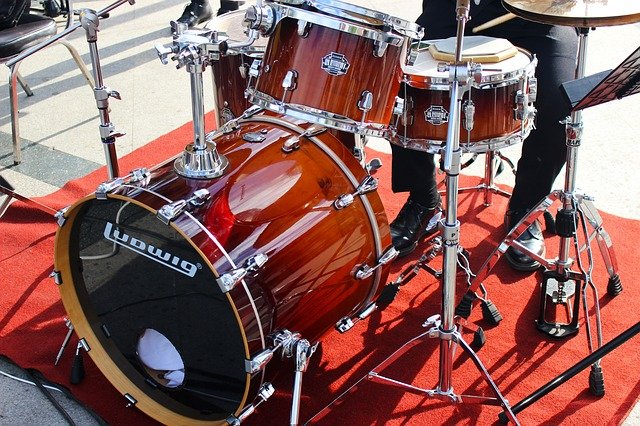Drum Kit Setting Up Essentials for Beginners
Image by Dean Moriarty from Pixabay
Setting up a drum kit may look effortless for many beginner drummers. However, the practice shows that quite a lot of green drummers don’t always position the parts correctly, which may lead to inconveniences and even side effects on health in the long run. If you’re a beginner drummer googling for a clear guide to setting up your drum, read further and set it up like a pro. If you need to gear up and get a good beginner snare drum, cymbals, or anything else, you’re welcome at simplydrum.com.
Start with Your Feet
First, sit on your drum throne and position your feet flat, shoulders on an equal distance from the core, and feel the solidness and convenience of this posture. Now, remember where your feet are and put the pedals there. If you have a right-handed kit, put the bass pedal on the right and on the left if your kit is left-handed. If there’s an additional pedal for a double bass mallet pedal, you should place it after adjusting the main bass pedal according to this recommendation.
Assemble the Kit
After finding the right position for your feet, you can attach the bass drum to the pedal, set up the snare, toms, and cymbal stands. Now the next step goes.
Adjust Hardware Heights
Make sure that your drum stool is at a comfortable height. Your knees should be bent almost 90°, and your hips should be a bit higher than the knees (just a tiny bit!). Next, adjust the snare stand. Here, you are free to experiment. Try to tilt it or leave it parallel to the floor if you like. The snare rim should be fist-wide higher than your thighs so that you won’t hit your leg when you make the next rim shot. A snare that’s too high will lead to the wrong elbow posture, extra tension, and poor technique development.
Toms Heights
Now, take care of your toms. The height of the floor tom’s rim should be about the same height as the snare rim. You can also slope it a bit towards yourself by adjusting one of the stands lower than others. It shouldn’t be too slanted as it may lead to messed-up strikes.
The tom mounting systems may differ by the manufacturer and kit model, so you should figure out how they are attached to the kit. Next, tilt them until you find the most convenient angle. Usually, both toms are tuned the same, but you are free to experiment.
Cymbal Stands
When it comes to the cymbal stands, you should place them close enough to be able to reach each cymbal without stretching your arms forward. It’s also important to find the optimal height that wouldn’t be too difficult to reach. Make sure that you don’t have to lean forward with your entire body and you keep the initial balance on the stool. Otherwise, you will overstrain your body, get tired too fast, and develop the wrong technique.
Each cymbal can be at a custom height and tilted the way you need. If you place them too low or too close to yourself, this may lead to hitting the cymbal instead of the tom or hitting both at the same time. This will cause terrible noise and make you spend more time setting up the stands differently. Don’t be disappointed if something goes wrong, though. It’s not bad to study from your own mistakes. Actually, it’s the only way to perfection.
Set It Up
Now it’s high time to go and set up your own kit to practice your knowledge. After a couple of setups, the whole process will feel natural to you and take significantly less time than it takes today. If it happens that you still feel uncomfortable or get tired too fast, try to experiment. And don’t forget to leave the kit and limber up to avoid muscle stiffness. Otherwise, you won’t progress as fast as you want. Have fun!

